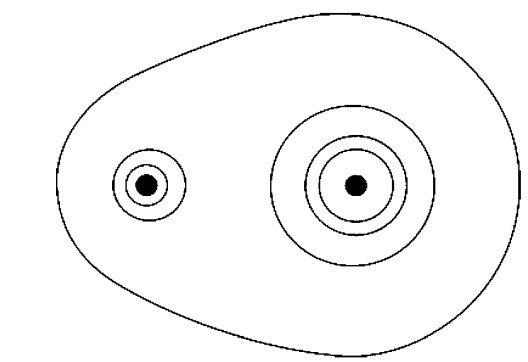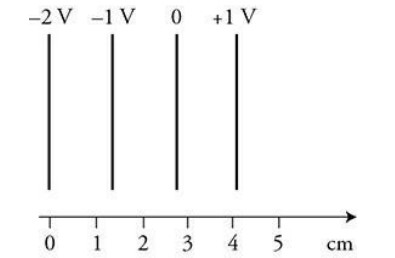Question
A physics problem starts: “A solid sphere has charge distributed uniformly throughout. . . ” It may be correctly concluded that the
(A) electric field is zero everywhere inside the sphere
(B) electric potential on the surface of the sphere is not constant
(C) electric potential in the center of the sphere is zero
(D) sphere is not made of metal
▶️Answer/Explanation
Ans:D
Solution: For charge to be distributed throughout a material, it must be non-conducting
Question

Isolines of equal electric potential in a region of space are shown in the figure. Points A and B are in the plane of the isolines. Which of the following correctly describes the relationship between the magnitudes and directions of the electric fields at points A and B?
(A) \(E_{A}=E_{B}\) and is in the same direction.
(B) \(E_{A}\neq E_{B}\) and is in the same direction.
(C) \(E_{A}=E_{B}\) and is in the opposite direction.
(D) \(E_{A}\neq E_{B}\) and is in the opposite direction.
▶️Answer/Explanation
Ans:D
Electric field lines are perpendicular to the isolines and point from higher potential to lower potential. The average electric field strength is E=\(\frac{\Delta V}{\Delta r}\). Therefore, the electric field at point A will be stronger than at point B.
Question

The figure shows isolines of constant electric potential surrounding two charges. Which of the following correctly describes the two charges?
(A) The charges are the same magnitude and the same sign.
(B) The charges are the same magnitude but different signs.
( C) The charges are different magnitudes but the same sign.
(D) The charges are different magnitudes and different signs.
▶️Answer/Explanation
Ans:C
Electric field vectors are perpendicular to the equipotential lines. The pattern of the electric field vectors indicates that both charges are the same sign. Additionally, there is no zero potential line separating the two charges, indicating that they have the same sign.
Question

In a region of space, there is an electric potential field with isolines as shown in the figure. Which of the following is the most accurate description of the electric field in the region?
(A) An electric field is directed to the left with a uniform strength of 3 V/in.
(B) An electric field is directed to the left with a uniform strength of 75 V/m.
(C) An electric field is directed to the left that increases in strength from left to right with an average value of 75 V/m.
(D) An electric field is directed to the right that increases in strength from right to left with an average value of-75 V/m.
▶️Answer/Explanation
Ans:
B—Electric fields are always perpendicular to the electric potential isolines and directed from more positive potentials toward more negative potentials. The electric field strength is calculated with the equation \(E=\frac{\Delta V}{\Delta r}=\frac{3V}{0.04m}=75\frac{V}{m}\)
Question
Which of the following describes the equipotential lines for the electric and gravitational fields that the proton experiences?
(A) Equipotential lines are straight, horizontal lines for both fields.
(B) Equipotential lines are straight, vertical lines for both fields.
(C) Equipotential lines are straight, horizontal lines for the electric field and curve upwards for the gravitational field.
(D) Equipotential lines are straight, horizontal lines for the gravitational field and curve upwards for the electric field.
▶️Answer/Explanation
Ans:A
Equipotential lines will be perpendicular to the force lines. Gravitational force lines point vertically downward. The equipotential lines for the electric field must also be
horizontal lines for the particle to move in a straight line at a constant speed.
